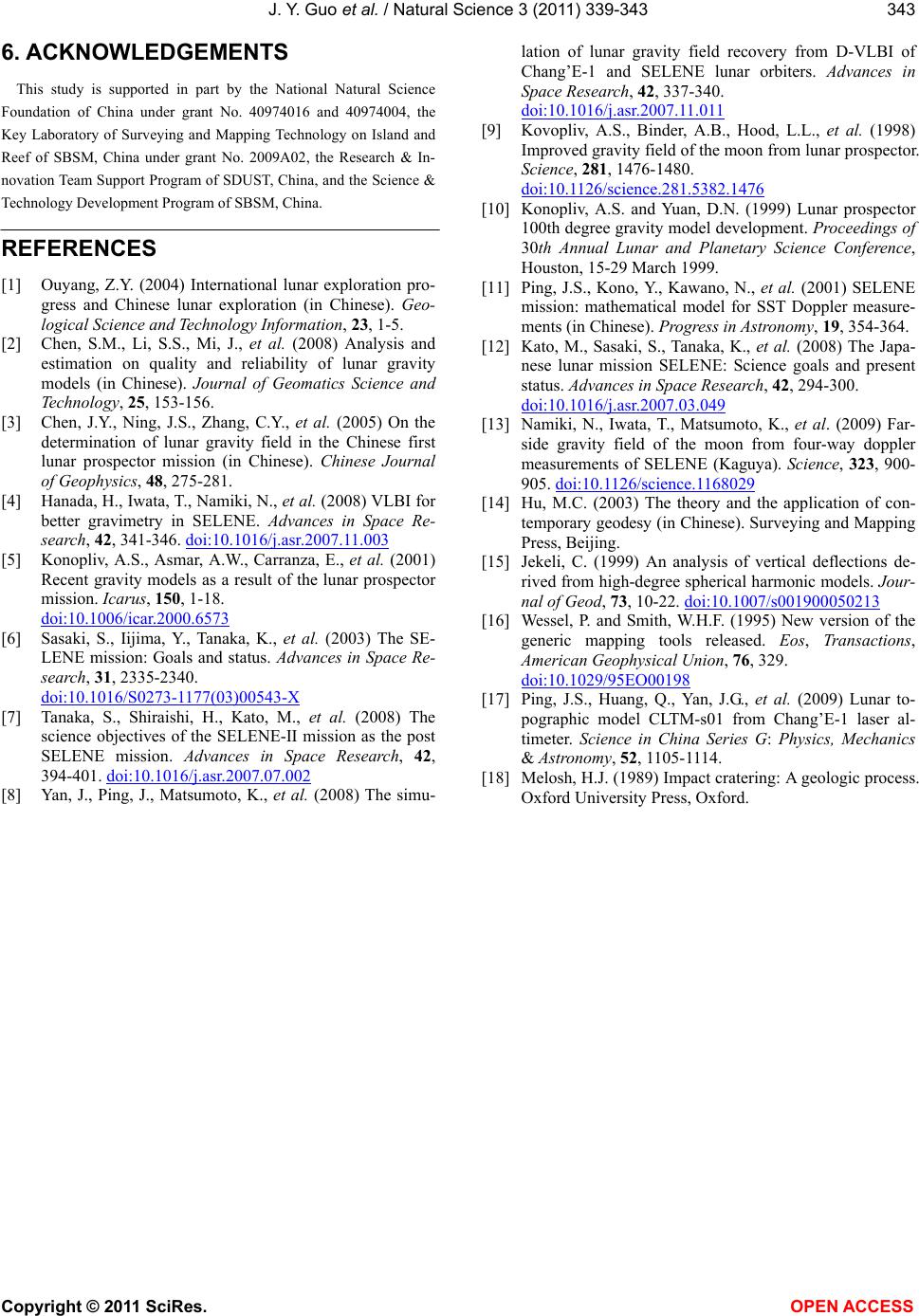
J. Y. Guo et al. / Natural Science 3 (2011) 339-343
Copyright © 2011 SciRes. OPEN ACCESS
343
6. ACKNOWLEDGEMENTS
This study is supported in part by the National Natural Science
Foundation of China under grant No. 40974016 and 40974004, the
Key Laboratory of Surveying and Mapping Technology on Island and
Reef of SBSM, China under grant No. 2009A02, the Research & In-
novation Team Support Program of SDUST, China, and the Science &
Technology Development Program of SBSM, China.
REFERENCES
[1] Ouyang, Z.Y. (2004) International lunar exploration pro-
gress and Chinese lunar exploration (in Chinese). Geo-
logical Science and Technology Information, 23, 1-5.
[2] Chen, S.M., Li, S.S., Mi, J., et al. (2008) Analysis and
estimation on quality and reliability of lunar gravity
models (in Chinese). Journal of Geomatics Science and
Technology, 25, 153-156.
[3] Chen, J.Y., Ning, J.S., Zhang, C.Y., et al. (2005) On the
determination of lunar gravity field in the Chinese first
lunar prospector mission (in Chinese). Chinese Journal
of Geophysics, 48, 275-281.
[4] Hanada, H., Iwata, T., Namiki, N., et al. (2008) VLBI for
better gravimetry in SELENE. Advances in Space Re-
search, 42, 341-346. doi:10.1016/j.asr.2007.11.003
[5] Konopliv, A.S., Asmar, A.W., Carranza, E., et al. (2001)
Recent gravity models as a result of the lunar prospector
mission. Icarus, 150, 1-18.
doi:10.1006/icar.2000.6573
[6] Sasaki, S., Iijima, Y., Tanaka, K., et al. (2003) The SE-
LENE mission: Goals and status. Advances in Space Re-
search, 31, 2335-2340.
doi:10.1016/S0273-1177(03)00543-X
[7] Tanaka, S., Shiraishi, H., Kato, M., et al. (2008) The
science objectives of the SELENE-II mission as the post
SELENE mission. Advances in Space Research, 42,
394-401. doi:10.1016/j.asr.2007.07.002
[8] Yan, J., Ping, J., Matsumoto, K., et al. (2008) The simu-
lation of lunar gravity field recovery from D-VLBI of
Chang’E-1 and SELENE lunar orbiters. Advances in
Space Research, 42, 337-340.
doi:10.1016/j.asr.2007.11.011
[9] Kovopliv, A.S., Binder, A.B., Hood, L.L., et al. (1998)
Improved gravity field of the moon from lunar prospector.
Science, 281, 1476-1480.
doi:10.1126/science.281.5382.1476
[10] Konopliv, A.S. and Yuan, D.N. (1999) Lunar prospector
100th degree gravity model development. Proceedings of
30th Annual Lunar and Planetary Science Conference,
Houston, 15-29 March 1999.
[11] Ping, J.S., Kono, Y., Kawano, N., et al. (2001) SELENE
mission: mathematical model for SST Doppler measure-
ments (in Chinese). Progress in Astronomy, 19, 354-364.
[12] Kato, M., Sasaki, S., Tanaka, K., et al. (2008) The Japa-
nese lunar mission SELENE: Science goals and present
status. Advances in Space Research, 42, 294-300.
doi:10.1016/j.asr.2007.03.049
[13] Namiki, N., Iwata, T., Matsumoto, K., et al. (2009) Far-
side gravity field of the moon from four-way doppler
measurements of SELENE (Kaguya). Science, 323, 900-
905. doi:10.1126/science.1168029
[14] Hu, M.C. (2003) The theory and the application of con-
temporary geodesy (in Chinese). Surveying and Mapping
Press, Beijing.
[15] Jekeli, C. (1999) An analysis of vertical deflections de-
rived from high-degree spherical harmonic models. Jour-
nal of Geod, 73, 10-22. doi:10.1007/s001900050213
[16] Wessel, P. and Smith, W.H.F. (1995) New version of the
generic mapping tools released. Eos, Transactions,
American Geophysical Union, 76, 329.
doi:10.1029/95EO00198
[17] Ping, J.S., Huang, Q., Yan, J.G., et al. (2009) Lunar to-
pographic model CLTM-s01 from Chang’E-1 laser al-
timeter. Science in China Series G: Physics, Mechanics
& Astronomy, 52, 1105-1114.
[18] Melosh, H.J. (1989) Impact cratering: A geologic process.
Oxford University Press, Oxford.